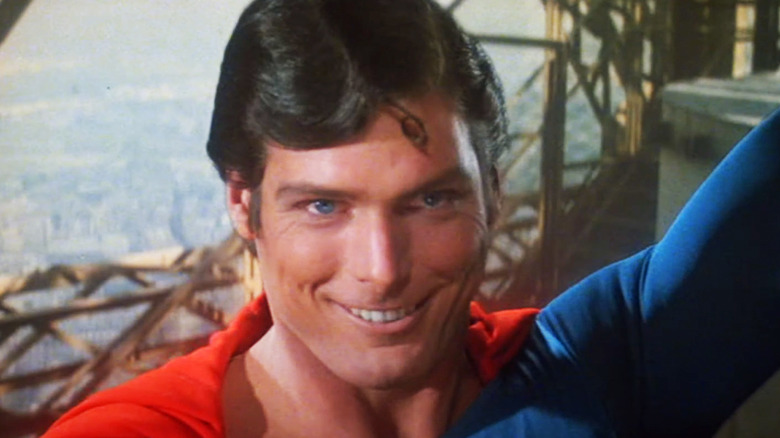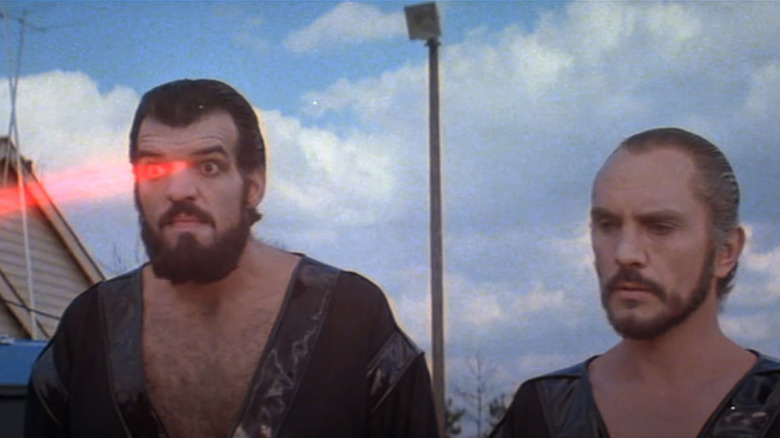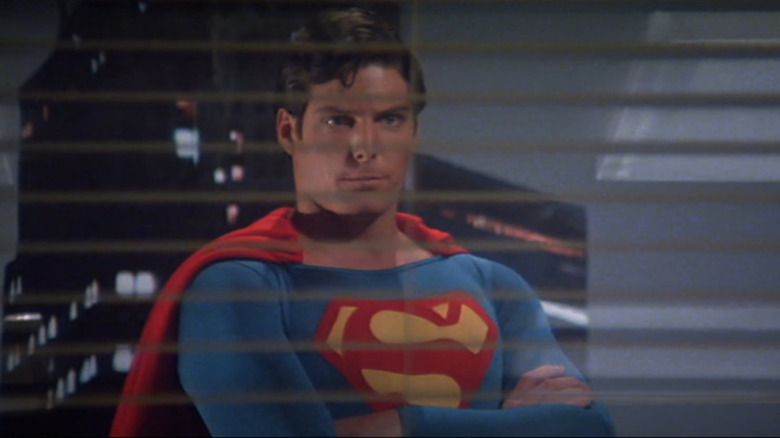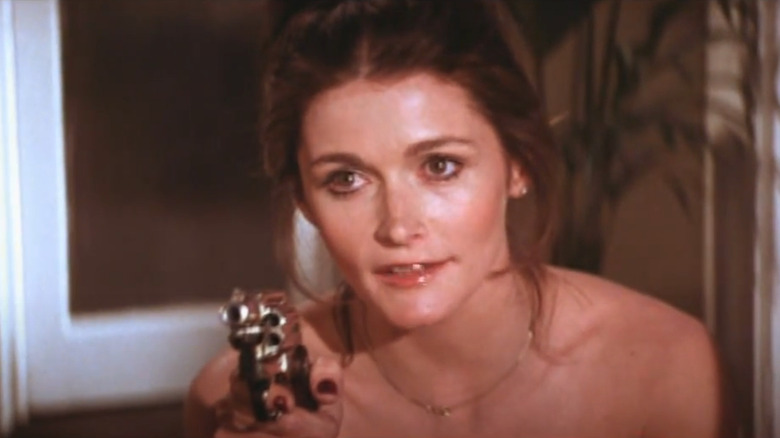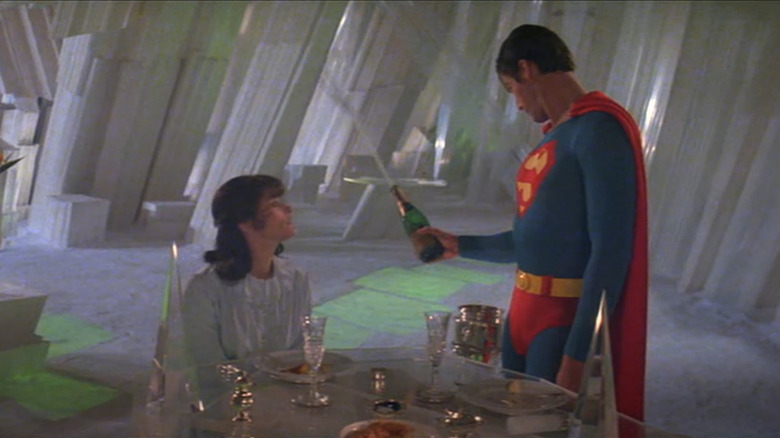Why Richard Donner Didn't Edit Superman II's 'Richard Donner Cut' Himself
It took a lot to bring "Superman" and "Superman II" to the big screen. Director Richard Donner and producer Alexander Salkind didn't get off to the best start, with Donner having to salvage a truly disastrous script that Salkind evidently felt was "perfect." But once "Superman" debuted in 1978, things started looking up. Or so it seemed.
With "Superman," Donner helped invent the modern blockbuster, setting a blueprint for every superhero movie that would follow and breaking box office records in the process. What made "Superman" an even more impressive feat was that during production, Donner had simultaneously shot most of the sequel. "Superman" and "Superman II" were filmed simultaneously, which meant the crew worked from a hefty script that required Donner to film scenes for both movies alongside one another.
Unfortunately, in order to make the "Superman" release date, Donner and co. had to stop filming "Superman II" before it was finished. And when the time came to resume filming on the sequel, tension between Donner and producers Salkind and Pierre Spengler resulted in the director being replaced by Richard Lester. The filmmaker behind "A Hard Day's Night" and "The Three Musketeers" was handed the reins after his predecessor had already shot around 75% of "Superman II," leaving Lester to complete the remaining 25%. But when the sequel debuted in 1980, significant portions had been reshot and many of Donner's original scenes were gone.
It was 26 years before Warner Bros. signed off on a director's cut that restored Donner's original vision, and in November 2006, "Superman II: The Richard Donner Cut" finally arrived. But oddly enough, the "cuts" themselves were handled by someone other than Donner.
Restoring Donner's vision
"Superman II" might just be the best Superman movie ever made, but that didn't stop fans from clamoring for Richard Donner's original cut. Michael Thau had worked as Donner's assistant before becoming an editor and director, and in a 2006 IGN interview, Donner explained how Thau told him there had been "so many requests to Warner Bros." for his original cut of "Superman II" that the studio had signed off on the project. Donner gave the "good little editor" his blessing to oversee recutting the footage, and work on "The Richard Donner Cut" began.
The process kicked off when six tons of film were shipped from London, where they'd been stored in the Technicolor vaults, to California where Thau was set to work on the recut. In a making-of featurette, Donner explained how Thau came to oversee the project:
"One day Michael Thau called me and said, 'Listen, there really is a internet movement afoot that they want to see your cut.' I said, 'I wouldn't know where to start,' and he said, 'Well, I'd love to do it.' I said, 'Hey, of all the people you're the right guy, go do it.'"
Once the newly-unearthed footage had gone through an extensive cataloging process, Thau started cutting scenes together, working from roughly 70% of what Donner had shot for "Superman II" before Richard Lester took over — the rest of this original footage had been lost in the decades since. During that process of editing, Donner, who'd never actually seen "Superman" in full before it premiered and had pretty much remained removed from the saga after he was replaced, preferred to maintain his distance somewhat.
'I'm too far away from it'
In a kind of prototypical "Zack Snyder's Justice League" process, Michael Thau and a small team worked diligently with Richard Donner's footage to restore as much of the director's original version of "Superman II" as possible. That involved using a screen test for one scene, in which Lois Lane shoots Clark Kent in a hotel room to prove that he is, as she suspected, Superman. Elsewhere, Thau and co. re-inserted scenes featuring Marlon Brando — whom Christopher Reeve wasn't a huge fan of — as Superman's father Jor-El, which had been removed from Richard Lester's cut after a dispute over pay between the actor and producers.
For most of that process, Donner let his team work with minimal supervision. As the director explained to IGN:
"[Thau has] been working for about four or five months now getting all the negatives and cuts out of England. A lot of it's been destroyed, a lot of it wasn't kept. But everything that he was able to [get], he said it will probably be about 70 percent my footage. [...] I don't even want to see it until it comes out in the theater."
Asked whether he did, in fact, want to see the final version, Donner said, "Oh, s*** yeah. But I don't want to cut it. I mean, I'm too far away from it now."
But it seems the "Goonies" director eventually did become more involved. As the making-of featurette shows, Thau would cut together footage by trying to match the editing style of Donner's first movie, "Superman," before showing the completed scenes to the director, who provided his former assistant with notes, and oversaw audio mixing sessions. It seems Donner couldn't totally resist having a hand in re-constructing his original movie.
'It's tough to look at'
Overall, bringing "Superman II: The Richard Donner Cut" to fruition took multiple months. Michael Thau worked with the footage he had to recreate as much of what Richard Donner had originally envisioned as possible. And even though the director did become quite involved once the process got underway, there's no doubt he preferred to keep some distance between himself and the project. As Thau explained in the making-of featurette:
"Donner came over and saw all the scenes, he also didn't want to deal too much with the [Richard] Lester scenes that needed to be left in to make a complete story. But I realized after a while that he had been familiar with those scenes and they hurt him, I think. That was always a sore spot."
While Donner's claim to IGN that he was "too far away from it" makes sense — it had been 26 years since the director was actually engaged in making "Superman II" — it seems there was more to his decision to hand the reins to Thau. The director seems to have been dealing with some residual hard feelings from being ousted from the project back in the late-70s. As he put it:
"I've looked at [Thau's cut] a couple of times. I've given my input as best I can, but I can't do it any more. I can't divorce myself from the disparagement of time, whereas he can because he's going in fresh, and he's doing a wonderful job. It's tough to look at."
Donner's legacy
Richard Donner spent what he claimed were two of the hardest years of his life on the original "Superman," and being removed from the sequel after shooting 75% of the scenes was a particularly bitter coup de grâce. With that in mind, it's understandable the director would find it difficult to return to the project, even after multiple decades.
Even though Christopher Reeve actually preferred Richard Lester's vision for Superman, there's no doubt much of what made the original "Superman II" so successful and enduring was Donner's doing. Not only had the director shot two movies simultaneously, he managed to deliver a hugely influential blockbuster with "Superman" that maintained a healthy reverence for the central character and established what many see as the definitive on-screen depiction of the Man Of Steel. Having his vision taken away before he could fully complete it must have been tough, and returning to it after so long understandably brought up mixed emotions for the director.
Thankfully, the "Richard Donner Cut" was well-received and provides as close a glimpse as we'll ever get at his original vision for the movie. Richard Lester would, of course, go on to take the "Superman" saga into more comedic territory, infamously directing Richard Pryor in "Superman III" and injecting a slapstick sensibility into the world Donner had created. Things didn't get much better after that, but Donner had set the bar so high with his first and (sort of) second movie that it was always going to be tough to maintain that quality. "Superman II" star Terrence Stamp believes the first two films set a high benchmark, and he's right. Had Donner been allowed to continue as director, who knows how long that benchmark would have been maintained.
